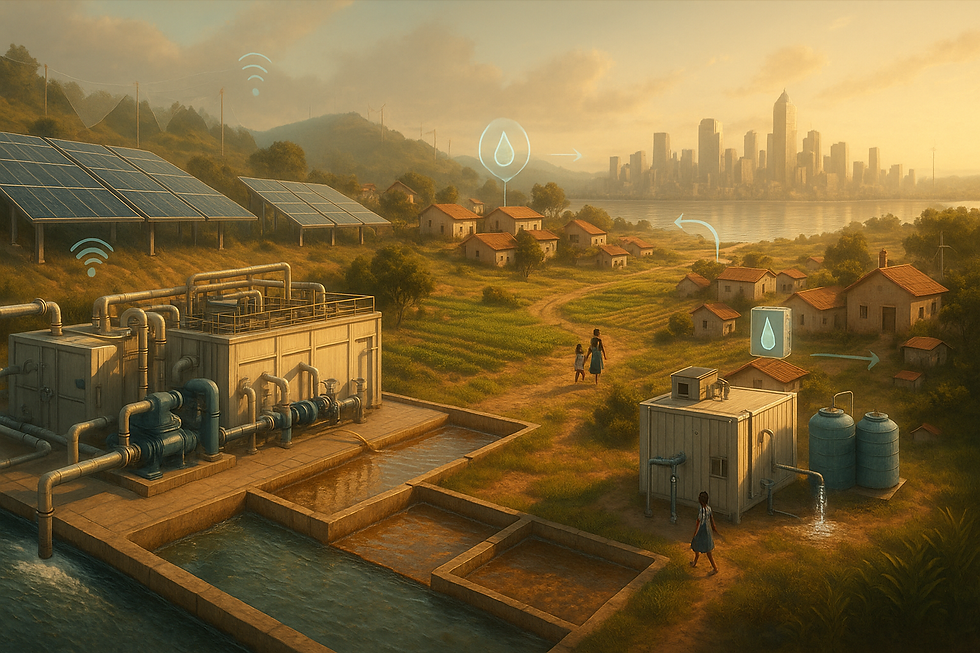Clean Water Solutions - A Comprehensive Research into Possibilities
- David B. N. J. & "A.I."
- Aug 21
- 5 min read

Download a summary here:
Download the reports here: (3 different)
Download a briefing, timeline, and FAQS here:
Listen to a podcast version here:
An Summary
What this project is
A consolidated blueprint for tackling the global water crisis with a pragmatic portfolio of technologies that already work today—plus a shortlist of next-generation ideas worth piloting. It consolidates 15 commercially promising solutions (TRL 5–9) and 5 emerging approaches (TRL 1–5), incorporating the “digital layer” (AI/IoT), and transforms them into a deployment playbook for governments, utilities, NGOs, and investors.
Why it matters
Two problems are converging: not enough water (droughts, overuse) and water that’s increasingly contaminated (pharmaceuticals, heavy metals, dyes, micro-pollutants). Legacy treatment plants weren’t designed for this chemical complexity; many emerging contaminants slip through and accumulate in ecosystems. Any realistic path forward must create new supply (e.g., desalination, water-from-air) and clean much better (e.g., advanced oxidation, novel membranes).
The portfolio at a glance (what’s in scope)
1) Advanced desalination (making the ocean or brackish water drinkable)
Reverse Osmosis (RO) + Solar PV (PV-RO). Now the world’s standard, with costs typically $0.50–$1.50 per m³ and energy needs slashed versus the 1970s; focus is shifting to smarter pretreatment, fouling-resistant membranes, and brine valorization (turning waste brine into useful chemicals).
Multi-Effect Distillation (MED) using waste heat from industry/power plants: higher CAPEX than RO, but compelling OPEX when heat is “free,” and very high-purity output—ideal for industrial co-location.
Membrane Distillation (MD) as a “brine concentrator” or for ultra-saline feeds; progress hinges on anti-wetting nanofiber membranes to boost reliability.
Capacitive Deionization (CDI) excels on brackish (low-salinity) water with low energy per ion removed; also promising for selective resource recovery (e.g., lithium, nutrients).
Nanofiltration (NF) for softening and color/organics removal, often as RO pre-treatment to cut energy and extend membrane life.
2) Harvesting water from air (decentralized supply)
Sorbent-based AWH (hydrogels/MOFs). Passive or low-energy water capture—even at low humidity—then solar release; suitable for off-grid households and clinics.
Fog harvesting with advanced meshes or “fog harps,” a low-cost option where persistent fog and wind exist (coastal/mountain zones).
3) High-efficacy purification & disinfection (cleaning better)
Advanced Oxidation Processes (AOPs) generate hydroxyl radicals to break down stubborn chemicals (pesticides, drugs). Powerful but energy/chemical-intensive—best for hotspots or polishing steps.
UV-C LED disinfection replaces mercury lamps: compact, efficient, chemical-free; perfect for point-of-use (must manage lack of residual disinfectant downstream).
Electrospun nanofiber membranes (customizable, high-flux) for targeted removal (e.g., heavy metals) and lower pressure operation.
4) Sustainable, accessible, decentralized systems
Decentralized Wastewater Treatment (DWWT) in containers or modular skids; avoids expensive sewers, enables local reuse (irrigation, flushing), and boosts resilience.
Point-of-Use filters (biosand, silver-impregnated ceramic) that dramatically cut diarrheal disease—simple, proven, low-cost.
Solar stills made from waste tires—upcycling carbon foams to create ultra-cheap passive desalination/evaporation units; field outputs have covered household needs at cents per liter.
Portable desalination from hand-powered RO to compact solar ED; valuable for boats, disaster relief, and remote communities.
5) The digital backbone: AI + IoT for the entire water cycleReal-time sensors + machine learning improve leak detection, optimize aeration and pumping (big energy saver), tune chemical dosing, and predict failures so plants run cheaper and safer. Think of it as the water sector’s “nervous system.”

Five next-generation ideas worth piloting (TRL 1–5)
Direct seawater splitting (co-producing green hydrogen and fresh water). Potential nexus win; still pre-commercial.
MOFs for low-humidity AWH (ultra-porous, tunable sorbents).
3D-printed aerogels for scalable solar desalination/evaporation.
Stimuli-responsive “smart” membranes that change selectivity on demand—opening the door to resource recovery from wastewater.
Bio-inspired designs (pufferfish gels, fog-harp geometries, frog-skin AWH).
Cost, energy, and maturity—fast facts
PV-RO is already cost-competitive at $0.50–$1.50/m³ and keeps getting cheaper as solar costs fall; energy for RO has dropped from >20 kWh/m³ in the 1970s to <4 kWh/m³ today. The next bottlenecks are fouling and brine.
MED shines when waste heat is available; lifecycle costs can beat RO in the right industrial ecology setup despite higher CAPEX.
AOPs are premium tools (often >€100/m³ for polishing); deploy surgically where persistent organics must be destroyed.
Digital optimization (AI/IoT) can cut aeration energy and unplanned downtime substantially—often the fastest ROI in existing plants.
How to pick the right mix (deployment logic)
Match solution to context
Coastal cities with sun + grid constraints: PV-RO with robust pretreatment; add hybrid RO→MD for high recovery and smaller brine volumes; explore brine valorization partnerships.
Industrial clusters: MED on waste heat for high-purity water; recycle process streams; integrate heat/power/water in a circular design.
Arid off-grid villages/clinics: AWH hydrogels or fog nets where climate permits; pair with UV-C LED or biosand/ceramic for disinfection; add small solar pumps and storage.
Inland brackish wells: CDI or solar-adaptive electrodialysis; low energy per ion and easier O&M for small systems.
Disaster response/boats: Portable RO/ED kits; simple, rugged, and standardized consumables.
Design principles
Go modular (containerized units, plug-and-play).
Combine low-energy passive with smart active steps (e.g., AWH + UV-C LED).
Instrument everything; let AI run optimization and maintenance scheduling.
Risks, gaps, and how the plan mitigates them
Brine & by-products: Prioritize high-recovery hybrids and invest in valorization (alkalinity chemicals, minerals) to shrink disposal and create revenue.
Membrane fouling/wetting: Specify pretreatment, choose fouling-resistant or nanofiber media, and monitor with AI to clean on condition—not on calendar.
ECs that resist conventional treatment: Use AOPs selectively and design for adsorption with green adsorbents (e.g., biochar, chitosan) where appropriate.
Equity & access: Elevate DWWT and POU filters for near-term impact while large plants are financed and built.
What “good” looks like (outcomes to aim for)
Cities shift from single, centralized plants to distributed, sensor-rich micro-plants feeding a resilient grid.
Utilities measure success not only in m³ produced, but energy per m³, recovery rate, EC removal, leakage reduced, and reuse achieved.
Industrial zones become water-positive by coupling MED/RO to waste heat/power and closing loops.
Timeline & momentum
A brief history shows RO’s energy use collapsing since the 1970s, MED maturing, and a recent surge in UV-C LEDs, AWH materials, containerized DWWT, and portable desalination. Near-term forecasts expect more cost declines in PV-RO and a growing market for compact systems; the R&D horizon is busy with MOFs, smart membranes, and seawater splitting.
Practical next steps (for implementers)
Map local needs and water quality. Classify by salinity, pathogens, ECs, energy prices, climate (for AWH/fog), and industrial heat sources.
Select a portfolio, not a single fix. Pair a base supply (e.g., PV-RO or DWWT reuse) with targeted polishing (AOPs, NF) and a disinfection layer (UV-C LED).
Instrument from day one. Deploy IoT sensors across intakes, reactors, and distribution; let AI optimize and flag maintenance.
Design for circularity. Recover heat, minerals, nutrients; treat brine as feedstock, not waste.
Stage pilots for the five emerging ideas. Start where they de-risk real bottlenecks (e.g., smart membranes in resource-recovery plants).
One-sentence takeaway
Water security won’t come from a silver bullet but from smartly combining mature, low-energy, decentralized solutions with a digital nervous system—while steadily piloting the next generation of materials-driven breakthroughs.
Here is a short video presentation of the project:





Comments